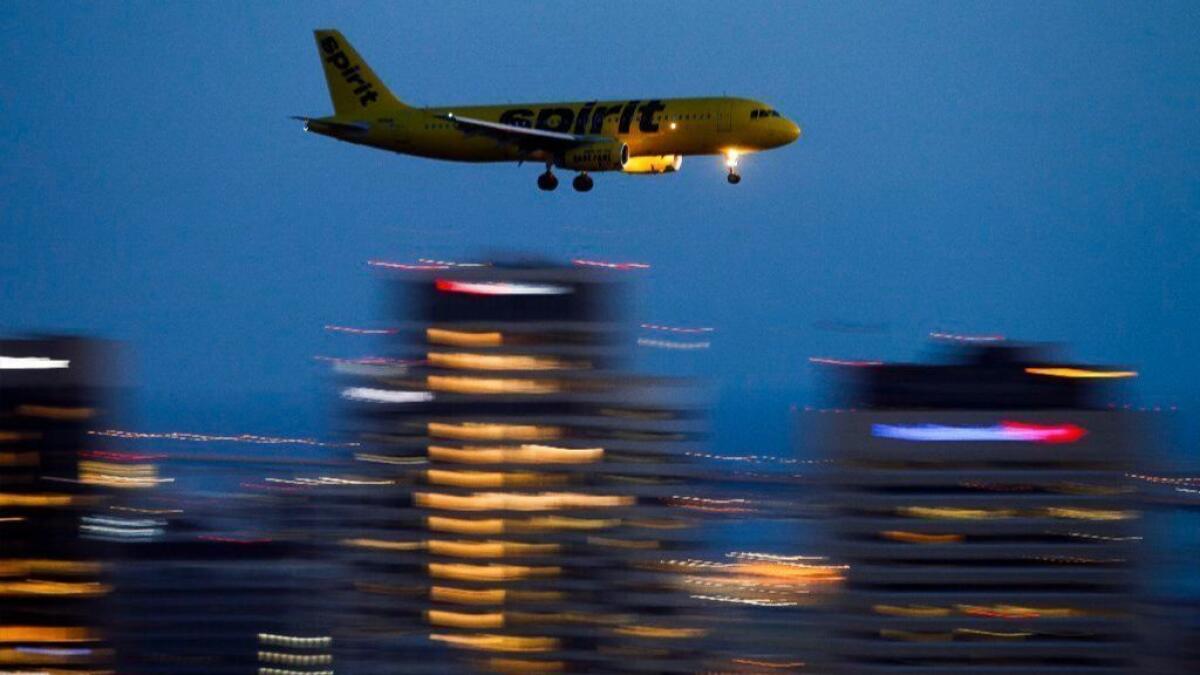Spirit’s new strategy: Be a less terrible airline

- Share via
When low-cost carrier Spirit Airlines begins new service from Hollywood Burbank Airport to Las Vegas later this month, passengers may be surprised to find the carrier do something it hasn’t been known for: Arrive on time.
And when the Florida-based carrier lands in Sin City, the chances that Spirit fliers will file a complaint about the service will be much lower than in the past.
The carrier that shook the airline industry a dozen years ago with its ultra low-cost fares and high fees has overhauled its business plan, easing back from its single-minded drive to maximize profits and focusing on improving customer service.
The result, so far, has been a lower profit margin but better service, fewer lost bags and fewer customer complaints. Spirit has even raked in a few industry awards.
“You gotta get the mix right, and it seems now that the mix is pretty good,” aviation industry analyst Seth Kaplan said of Spirit Airlines.
Spirit still has one of the highest rates of passenger complaints when compared to its industry rivals, but the carrier has dramatically reduced that rate to 1.74 complaints for every 100,000 passengers in March from 9.68 complaints in March 2016 as the reinvention was being launched, according to federal statistics.
The changes at Spirit helped win the carrier the titles this year of “value airline of the year” by Air Transport World, an online trade publication, and “most improved airline of the year” by the Airline Passenger Experience Assn., an industry trade group that relies on ratings by passengers flying on nearly 500 airlines to judge carriers.
“Their improvement matches the incredible strides that they have made in being one of the best airlines in the U.S. Department of Transportation reports for on-time performance,” the group’s chief executive, Joe Leader, said in a statement.
But Kaplan said that Spirit Airlines didn’t adopt a more passenger-friendly business plan for altruistic reasons. As larger rivals began in the last few years to sell bare-bones fares to compete for budget-minded travelers, Spirit Airlines was forced to reconsider its niche in the industry, he said.
“It wasn’t enough for the airline to be cheap because everyone was cheap,” Kaplan said.
Spirit Airlines appears to be following the lead of Ryanair, an Irish low-cost carrier, which tried to improve its reputation as the most hated European airline when its chief executive, Michael O’Leary, promised in 2013 to “stop unnecessarily pissing people off.”
Similarly, Domino’s Pizza in late 2009 launched a self-deprecating advertising campaign admitting that its pizza was bad and promising to do better with a new line of artisan pizza, remodeled restaurants and improved technology.
It’s a fraught strategy.
Ryanair Holdings and Domino’s have enjoyed a resurgence in revenue, earnings and stock price, although Ryanair lost some ground in the last fiscal year amid labor problems. And both remain subject to rude memes such as “Domino’s Still Sucks!”.
Some Spirit passengers say they have seen an improvement in the airlines’ service, but they say fliers must be prepared to pay fees for services they normally get for free on other carriers.
“The trick with Spirit is that if you know what you’re getting in to, you’re going to be fine if you do the math,” said Jason Rabinowitz, a travel blogger from New York, who often flies Spirit to Florida on leisure trips because of the low fares. “Spirit isn’t always cheapest after all the bag and seat fees, but it often is.”
Spirit Airlines still has plenty of critics, many of whom post their gripes about the airline on social media.
“They are the worst,” said Mandy Podlesny, a Keto nutrition coach from South Carolina who flies Spirit Airlines for business on a regular basis because she has few other choices from her nearest airport, in Myrtle Beach.
Her latest flight from South Carolina to Philadelphia was delayed for two hours but the gate agent and her pilot gave conflicting stories about the cause of the delay.
“They just really don’t care about customer service,” she said.
Still, the turnaround at Spirit Airlines has caught the attention of industry experts.
“It looks like management is doing something right,” said Madhu Unnikrishnan, editor of the trade publication Airline Weekly.
Only three years ago, Spirit Airlines had the industry’s worst on-time arrival rate and among the highest rates of lost luggage and passenger complaints.
The latest government data show that Spirit Airlines had a 86.4% on-time arrival rate in March, behind only Hawaiian Airlines, with an 86.8% rating. In contrast, Spirit was ranked last among all major airlines in March 2016, with an on-time rating of 64.7%, according to federal data.
In January, the U.S. Department of Transportation changed the way it calculated the rate of lost and mishandled bags. Instead of reporting the number of lost bags for every 1,000 passengers, the federal agency now calculates the rate of lost bag reports for every 1,000 bags brought onto the planes. As a result, the overall rate has jumped for all airlines.
Although Spirit Airlines’ lost bag rate climbed under the new calculation, the carrier’s rate dropped in comparison to its rivals. Spirit went from having the highest rate of lost bags among the nation’s largest carriers in March 2016, to the third lowest rate in March 2019, behind Allegiant and Frontier Airlines.

One of the keys to turning the airline around, according to Spirit Airlines Chief Executive Ted Christie, was adding more time in between flights to respond to unforeseen problems such as mechanical issues and staffing snafus.
When an airline flies back-to-back flights around the clock, a delay in one of those flights creates a ripple effect that disrupts the schedule of many subsequent flights. Such delays can cost the airline to pay staff overtime or to rebook passengers from delayed flights, among other expenses.
“We believed that among other things, we were causing disruptions and spending money to resolve those issues on the back end,” Christie said during an interview at Los Angeles International Airport. “If we backed the airline [off] just a tad, we will save enough money on the back end to justify the extra time.”
The other key to Spirit’s turnaround, he said, was increasing communication between workers and executives to fix ongoing problems.
This was done by scheduling a weekly meeting every Thursday at 3:30 p.m. at the Spirit Airlines headquarters in Miramar, Fla., with executives, representatives for the flight attendants, baggage handlers and others to discuss ongoing headaches and chokepoints.
The meetings began informally in spring 2016 under the leadership of the previous chief executive, Robert Fornaro, and continued after Christie took over the helm in January.
Among the topics discussed at the meetings were which flights were most often delayed and why, how staffing problems could be improved and whether additional terminal gates were needed to keep the planes on schedule.
“The best way to get a complex logistics company to run well is for people to break down walls and talk about it,” he said.
With fewer delays and less lost luggage, complaints declined and morale improved, Christie said.
“As the business runs more smoothly and interaction with guests are much more positive, that feeds upon itself,” he said.
Only a few years ago, Spirit had the highest profit margin in the industry, partly thanks to the revenue it generated from bag fees and charges for food, drinks and traveling with pets, among other expenses.
Spirit still loves to charge extra for everything under the sun. But since the carrier began focusing on customer service, Spirit Airlines’ income excluding special items rose to $300.9 million in 2018, compared to $291 million in 2016, the first year of Fornaro’s initiatives. In that same period, the net income margin dropped from 13.5% from 19%, according to Spirit Airlines earnings reports.
But Spirit Airlines representatives say the lower margins are primarily due to other factors, including higher fuel prices and a new, more expensive contract with pilots.
In that same span, the carrier has grown from a fleet of 95 planes with 4.9 million “passenger flight segments” in the first quarter of 2016 to 133 planes and 7.8 million flight segments in the same period in 2019. A passenger flight segment is any point of a trip where passengers can get on and off a flight.
Financial analysts say the drop in Spirit Airlines’ profit margin is not a reason to worry because higher fuel and salary costs have pushed profits down for almost all airlines in the last few years.
The changes that Spirit Airlines has made to improve its customer service are a positive development for the carrier, said Betsy Snyder, an analyst at credit rating firm Standard & Poor’s Corp. Ultimately, she said, Spirit Airlines will thrive by offering what budget-minded passengers want: Low-cost fares.
“If you are a low-cost airline, people are going to fly you because of your price,” she said.
Other data suggest the recent changes made at the airline have not hurt the bottom line.
Spirit Airlines reported in 2018 generating 9.10 cents in revenue per available seat miles flown — an industry measurement that gauges the efficiency of an airline. In 2016, the carrier reported 9.11 cents in revenue per available seat miles.
The company’s stock price is up 54% from the most recent low of $33.41 a share in September 2017, closing Thursday at $51.40.
In addition to adding flights from Burbank to Las Vegas, Spirit Airlines plans to launch service on June 20 from Sacramento to Las Vegas. That will make Sacramento the fifth California airport served by Spirit.
The airline is primarily targeting leisure destinations in North and South America, including Mexico, Jamaica and Costa Rica. Christie said Spirit Airlines has no immediate plans to expand to markets in Europe.
Such a move, he said, would require adding long-range aircraft, which would make Spirit Airlines’ business plan more complex.
“What we do today and the opportunities we have, we do well because we are focused on what we think we can be best at,” he said.
More to Read
Inside the business of entertainment
The Wide Shot brings you news, analysis and insights on everything from streaming wars to production — and what it all means for the future.
You may occasionally receive promotional content from the Los Angeles Times.











